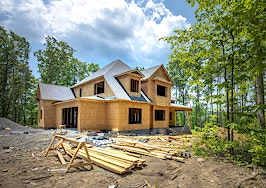This report is available exclusively to subscribers of Inman Intel, a data and research arm of Inman offering deep insights and market intelligence on the business of residential real estate and proptech. Subscribe today.
For well over a decade now, it’s been well documented that homebuilders haven’t kept pace with the actual need for new homes throughout the U.S.
But it’s not the recent past that has Alec Hartman worried about the potential rise of a home affordability crisis. It’s how much the present conditions resemble a similar period from decades ago.
The co-founder and CEO of Welcome Homes spoke with Intel for a wide-ranging interview on the risks — and opportunities — ahead for homebuilders, construction startups and investors in the proptech space. His responses below have been edited for length and clarity.
Intel: Thanks again for talking with us. Can you give our readers a quick rundown on how Welcome Homes works? What are the biggest ways the consumer experience differs from working with a traditional homebuilder?
Hartman: There are quite a number of differences, but from a consumer’s perspective, it should feel like a product you’re buying. Not like a custom service you’re chartering or this thing that you’re moving into that has a lot of uncertainty. This is buying a home like you’d buy something on the shelf at the store. You get to customize it online — it’s not a custom home — and it helps the customer gain a lot of value, gain a lot of speed, gain a lot of efficiency, because there are models that we’ve curated in advance. And the construction process is also value-engineered. So you get all the benefits of a product, and it’s just much faster and easier.
How does the actual construction process work on your end?
We have building partners in every region that we operate in. Those are the partners that are handling all the builds for our customers. They have pretty specific, pretty deep knowledge of every area. They’re local. They have local labor. So Welcome’s doing the management of all of those projects. We’re sitting in, sort of doing customer experience for the customer, and we’re handling all the stuff that’s not on-the-ground building so the builder can focus on doing the building. So that includes all the logistics, procurement, all the financial management. Everything that is complex and unnecessary for a builder to touch, including permitting and entitlements, Welcome handles that. It’s a very consolidated platform for doing that. And the customer doesn’t have to touch that either.
Are there any technology-related efficiencies that you guys have been able to find on the construction side or the project-management side?
Welcome is a tech company because of our civil-engineering and land-prep technology. Understanding what it takes to build on any given lot or any given teardown — almost across the U.S. at this point, but within our regions — is what makes Welcome a tech company. So we can dynamically evaluate everything, from rock formation, soil depth — all the stuff that you’d need to know to do really good prep work and estimate a build, we do that. And we get so confident in it that we can offer a guaranteed price to customers on the whole construction. That’s really the tech that Welcome does. We build a lot around civil engineering, and we can even algorithmically determine site viability. We’re almost to the point where we can fully automate site plan design. It’s not quite ChatGPT, where you get that type of response. But it’s kind of getting close to the equivalent of dynamically generating site plans and understanding what’s involved from the municipality level. We do use efficiencies on the builder side. We use tech to do basic project management, but I don’t think that’s the real unlock. The real unlock is getting land situated.
You mention the idea of a dynamically generating site plan. Is that using kind of an AI-type approach, like the ChatGPT notion, or is that a totally different process that you use to generate those?
At present, we use brute-force [search] for what we’re dynamically experimenting with. We do have a land team, so we have civil engineers, and nothing is just purely algorithmically generated. We do have a land team in place, and expect to be using them and finalizing projects with them forever. For just identifying the rules and creating a site plan that works with that, the best method at this point is brute-force, in our opinion, which is just trying permutations and comparing them against the rules that we’re aware of.
Since the housing crash of 2007, builders have failed to keep up with the real-world need for new housing units. I’ve seen estimates that we’ve underbuilt by somewhere between 1.5 million and 5.5 million housing units in that time. Going forward, what do you think the role of proptech companies will be in helping to close that gap?
I like to look at 1981-83 as a reference point, because that was the last time we had a broad recession that didn’t have one underlying cause. And it was mostly outside of anything to do with housing. So 2007-2008 didn’t feel like the right example to me. There are a lot of things that are more in common [with the 1980s] about how we’re fighting these recessionary tendencies now vs. in 2007. It was a completely different fight. But in 1981-83, it was pretty much the exact same playbook. It was this exact same interest-rate climate, the exact same suppression of purchasing. And in that time, I found that there were really, really interesting statistics. Home affordability was further out of reach than what it is today, yet the population growth relative to the number of housing units was even more of a disparity. And what happened was, builders stopped building in the early ’80s because of the recession, and then that inventory demand piled up. And I believe home prices increased 78 percent the following decade, which is pretty big.
If that were to happen today, let’s assume coming off of the high-point mark, let’s say we depress 20 percent but then escalate 78 percent, we would have a giant home affordability crisis in the U.S. Like, giant, giant, giant, giant, giant, giant.
But there is a tendency, and rightfully so, of people to put their money into their primary asset: i.e., their home. And I bet that’s what’s going to happen again. So pushing out more units now, while we’re able to, and while there’s a wall before an increased demand, is probably the most responsible thing that builders can do. Yes, will they take a haircut on profits? Probably. And they probably should, for the betterment of everybody who wants to buy a house. It’s going to be a numbers game, and numbers within certain subsets, and I don’t think that people understand how many homes we really do need to produce the right way in order to combat an affordability crisis in seven years from now.
Just realistically speaking, do you think that the industry is likely to put out that many homes in advance of the demand wave that you expect hitting?
No. They’re not likely to. It doesn’t make any sense. Because the margin profile is not there. In public markets, you can see that homebuilders, because their debt limits really haven’t been divested since 2007-2008, their long-term debt holdings and their medium-term debt holdings are still fairly substantial, and they weren’t that way in the ’80s. All of the dynamics that we’re looking at make it very disincentivizing for any sort of major homebuilder to take the risk. There’s less upside. So the problem warrants the risk, but there’s no [immediate] reason to take it.
Anecdotally, at least, I feel like within the proptech world we’ve seen new investment money turning a bit away from transaction tech, and toward finance and construction platforms. Where do you see proptech heading, as an investment category?
There was a lot of capital put into [those solutions] because there was a lot of ingenuity and consolidation from, I would call it, the first real class of proptech companies. I think we’re basically on the second to third class of proptech companies. And given the macro climate, the expectation is that they’re more [capital expenditures]-light, but that they functionally achieve similar things. And I think that’s why it’s going more toward the proptech-tech side of things. Because there’s the hope that the efficiencies that we’ve seen in consolidation can happen without that consolidation of capital.
You see great companies that are getting funding now — like tech-enabled [property] management companies — you see that type of proptech company starting to really be favored by investors. And I think that there’s a good reason for it, because it plugs in, it provides immediate value, and there is a clear path towards creating standards in an industry that hasn’t evolved its standard for a very long time. And so that’s probably a pretty good use of [venture] capital.













